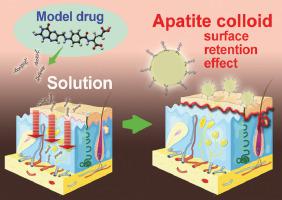Acta Biomaterialia ( IF 9.4 ) Pub Date : 2020-05-18 , DOI: 10.1016/j.actbio.2020.05.010 Maëla Choimet 1 , Audrey Tourrette 2 , Olivier Marsan 3 , Giovanna Rassu 4 , Christophe Drouet 3

|
Most treatments of skin pathologies involve local administration of active agents. One issue can however be the partial transcutaneous diffusion of the drug to blood circulation, leading to undesirable effects. In this work, the original use of submicron mineral particles based on bio-inspired calcium phosphate apatite was explored for the first time as drug carriers for favoring topical delivery. The permeation of a model drug across synthetic and biological membranes was investigated in both static and dynamic conditions. Our data show that adsorption of the drug on the apatite particles surface drastically limits its permeation, with lower effective diffusion coefficients (Peff) and smaller total released amounts. The retention of the apatite colloidal particles on porcine ear skin explants surface was demonstrated by combining histological observations and Raman confocal microscopy. All results converge to show that association of the drug to apatite particles favors skin surface effects. These findings point to the relevance of mineral-based particles as drug carriers for local delivery to the skin, and open the way to novel applications of bio-inspired apatites in dermatology.
Statement of Significance
Calcium phosphates (CaP) are major biomaterials in orthopedics and dentistry. Their resemblance to bone mineral allows new applications beyond bone repair, e.g. in nanomedicine. In 2018, a 14-page detailed review (M. Epple, Acta Biomaterialia 77 (2018) 1–14) provided clear facts in favor of the non-toxicity of nanosized CaP as an answer to discussions from EU and US study groups, thus clarifying the path to novel applications of nano CaP. In the present paper, bio-inspired apatite nanoparticles are used for the first time as drug carriers for dermatology for drastically limiting drug transcutaneous permeation and retaining a topical effect. We demonstrate this proof of concept via permeation cell tests, histology, Raman microscopy and photoluminescence after application on porcine ear skin.
中文翻译:

受生物启发的磷灰石颗粒限制了皮肤科药物在皮肤中的渗透。
皮肤病理学的大多数治疗都涉及局部施用活性剂。但是,一个问题可能是药物在血液循环中的部分经皮扩散,从而导致不良后果。在这项工作中,首次探索了基于生物启发的磷酸钙磷灰石的亚微米矿物颗粒的原始用途,作为有利于局部递送的药物载体。在静态和动态条件下都研究了模型药物在合成膜和生物膜上的渗透性。我们的数据表明,药物在磷灰石颗粒表面的吸附极大地限制了其渗透,有效扩散系数较低(P eff)和较小的总释放量。结合组织学观察和拉曼共聚焦显微镜证实了磷灰石胶体颗粒在猪耳皮肤外植体表面的保留。所有结果趋于一致,表明该药物与磷灰石颗粒的结合有利于皮肤表面效果。这些发现表明,基于矿物质的颗粒作为药物载体可以局部递送到皮肤上,并为生物启发性磷灰石在皮肤病学中的新应用开辟了道路。
重要声明
磷酸钙(CaP)是骨科和牙科中的主要生物材料。它们与骨矿物质的相似性使得其可以进行除骨修复以外的新应用,例如在纳米医学中。在2018年,一份长达14页的详细评论(M.Epple,Acta Biomaterialia 77(2018)1-14)提供了明确的事实,支持纳米级CaP的无毒性,以此来回答欧盟和美国研究小组的讨论,因此阐明了纳米CaP的新应用之路。在本文中,首次将生物启发性磷灰石纳米颗粒用作皮肤病学的药物载体,以大大限制药物的经皮渗透并保持局部作用。我们通过在猪耳皮肤上应用后的渗透细胞测试,组织学,拉曼显微镜和光致发光证明了这一概念证明。











































 京公网安备 11010802027423号
京公网安备 11010802027423号